Miele WDB020 Review
Miele WDB020 Review
An incredibly efficient 7kg washing machine
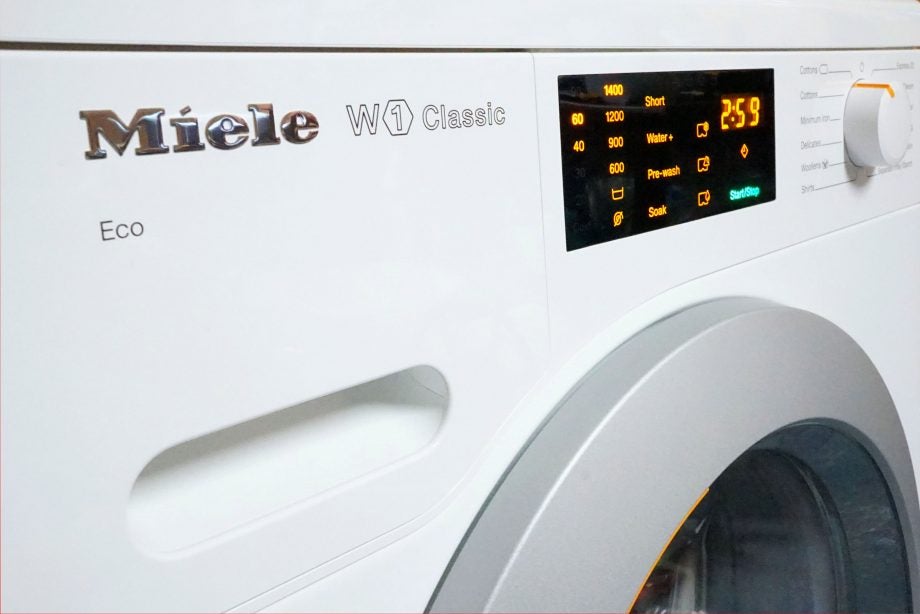
Verdict
Pros
- Exceptionally easy to use
- Great wash results
- Potentially amazing efficiency
- Very low water consumption
- Choice of innovative Caps
Cons
- Limited 7kg drum size
- Half loads not as efficient
- Eco cycle not the most eco
- Only average spin efficiency
- No caps supplied
Key Specifications
- Review Price: £649.99
- 7kg load capacity
- A+++ energy efficiency
- 1400 spin speed
- CapDosing
- Simple controls
- Honeycomb drum
- 20min quick wash
What is the Miele WDB020?
Miele is famed for its premium appliances, but can the more affordable WDB020 deliver the same performance and quality? This is an A+++ energy rated 1400-spin machine with Miele’s innovative CapDosing system – yours for under £650.
The WDB020 has much of the quality of Miele’s top appliances, delivers great wash results and is simple to use. Programmes are limited and its hampered by the limited 7kg capacity and small porthole door, however. Nevertheless, for smaller families with basic daily washing requirements it’s spectacularly energy- and water-efficient.
Related: Best washing machine
Miele WDB020 – What is it like to use?
A Miele washing machine under about a grand is a rare beast. The brand operates at the upper-echelons of the domestic appliance market, where outstanding build quality, innovative features and energy label ratings with more A+’s than Einstein’s school report is the norm.
The WDB020 aims to bring much of that high-end goodness to a more affordable level. While 650 quid is still a fair pile of cash for a washing machine, the specification omens are good. A+++ energy rating, low noise, load-sensing and a claimed 10.3 cubic metres of water use per year are all stellar.
The mini-elephant in the wash pile is that 7kg drum capacity. That’s fairly small compared to many competitors at this price point. Many promise up to 10kg loads at this level, and the Miele’s porthole door is equally compact. Getting a duvet in there is a proper wrestling match. On the plus side, this Miele does handle its full capacity in real-world washing.
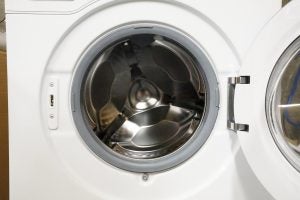
While the programme count is limited, the WDB020 isn’t without its share of hero features. The drum is Miele’s stainless-steel honeycomb design, which promises to be gentle on your clothes while improving spin-drying performance.
This machine also offers Miele’s CapDosing system. This allows you to use a range of Miele’s specialist detergent and fabric-conditioning liquids in convenient cap form that clip into the soap drawer. Frustratingly, no sample caps are supplied with the machine, but Miele does usually have promotions and discount offers in the paperwork pack.
Related: Best tumble dryer
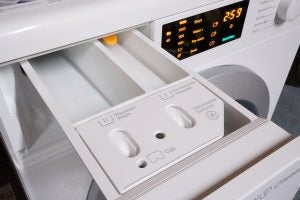
The soap drawer requires a robust pull and feels very solid. The same can be said of the door: it requires a firm tug, but opens and closes with a proper ‘thunk’ that suggests a door-catch life expectancy measured in decades rather than years.
There are a couple of un-Miele-like fixture and fitting compromises, though. The small flap that hides the pump-filter has a finger-hole and simple plastic clip compared to all-metal roller catches on Miele’s upmarket models.
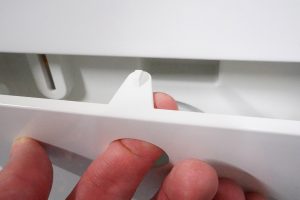
While the WDB020 has what initially looks like a complex LCD panel, fear not. The display is a black panel that responds to a solid prod of the finger on any selected temperature, mode or spin speed icon. Once selected, the relevant icon lights up brighter and the segment display indicates the maximum time for the selected wash combination. Actual run-time could be a whole lot less on some cycles with smaller, cleaner loads as a result of Miele’s wash load-sensing.
Together with the rotary programme selector knob, the WDB020 is wonderfully simple to use. Choose programme, adjust temp or spin speed if required, choose one of four options and press Start/Stop.
Related: Best fridge freezer
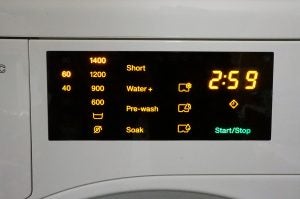
Miele WDB020 – How noisy is it?
Miele machines have consistently lived up to their energy label promise for noise, and the WDB020 is no exception. We measured spot-on the claimed 50dB wash noise and 74dB peak spin noise in our tests, but the reality through the cycle is a little more complex than that.
In most cycles, the wash phase burbles along at around 47-48dB average. The sound is quite variable, though, with the output bouncing regularly between silence while the wash soaks briefly and a 52dB peak. While 52dB isn’t overly noisy, the ‘pulsing’ sound is slightly more irritating than a constant drone should you be considering a kitchen power-nap.
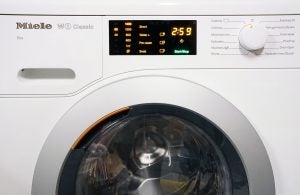
Conversely, while a spin noise of 74dB isn’t super-quiet by modern standards, that output happens only infrequently as the motor accelerates to 1400rpm. As soon as the machine gets to top speed, the output settles down to a much more impressively quiet 67-68dB
Our only other noise note was a strange gurgling coming from the soap drawer on pump-out. This was quite intermittent and seemed to disappear with use; it may have been the result of an air-lock in the system from delivery.
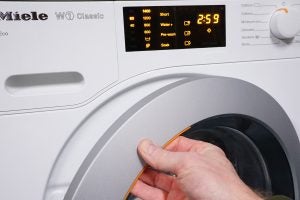
Miele WDB020 – What programmes does it have?
For those of us who tend to use only a handful of programmes, this Miele keeps choices simple. It has just 10 main wash programmes.
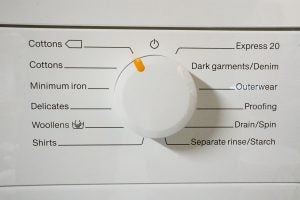
The headliners are Cottons Eco (with the arrow symbol) and standard Cottons. Confusingly though the Eco mode is not always the most economical of the two. The Eco cycle is near 3 hours long and uses set resources almost regardless of load. The Cottons cycle adapts the wash to the load and soiling level… meaning smaller, less dirty loads will be cheaper on the standard Cottons programme.
Delicates, Woollens and Minimum Iron cycles use a gentler drum action and reduced spin speed for smaller loads. The Shirts programme handles up to 2kg of mixed fibre shirts and blouses in an hour and a half while the Dark/Demin wash is designed to keep colours from fading. If you need a speedy half load, the Express 20 programme will do 3.5kg of cottons in just 20minutes.
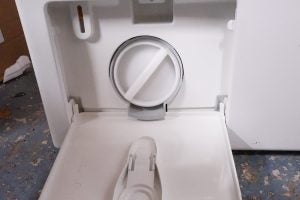
The person who specified this machine’s programme line-up was definitely an outdoor enthusiast. The only special programmes you get here are an Outerwear cycle approved for use with the likes of Gore-Tex and a Proofing cycle designed to re waterproof technical fabrics using the relevant proofing solutions. Thankfully neither programme have hiked the machines price.
You can change the default temperature and max spin speed of each programme and further options are succinct. You can shorten the cycle’s wash time and number of rinses for lightly soiled loads, while the Pre-wash and Soak options are there for seriously dirty laundry. There is an anti-crease function and a Water+ option. That is unusual in that it increases volume of water in both the wash and rinse stages should you feel the need. Delay Start and Rinse Hold are included to fine tune your laundry timings.
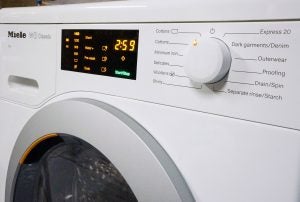
If you are using any of Miele’s extensive CapDosing caps, you can select one of three modes. ‘Fabric Care’ for proofers and conditioners, ‘Additives’ for detergent enhancers and ‘Detergent’ for main wash detergent caps. Miele has a whole range of caps to choose from, each designed for a single full load. Prices are around 65p to just over £1.70 per cap, depending on type.
Miele WDB020 – How well does it wash?
Stuffing our usual 80% of claimed load of dry cottons into the drum was a bit of a squeeze. That porthole door opening is pretty small although the drum did just about swallow the entire 5.6kg of mixed cotton items.
Into the load we placed our regular test stain strip. This features 24-hour dried on blood, coffee, turmeric, ketchup, blackberry juice and engine oil. We used a leading non-bio liquid detergent directly into the soap drawer and set the machine on the standard Cotton programme at 40 degrees.
Wash results were very good if falling a little shy of the super-buffed clean performance of Miele’s top washers. The blood, coffee, ketchup and blackberry were gone save the very faintest of residual shadows. The turmeric and oil had been significantly diminished. It’s a great result and using bio detergent would have resulted in a very clean strip indeed.
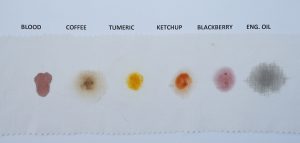
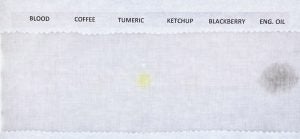
Moreover, the WDB020 sipped water and used very little electricity in the process. Detecting the load was very lightly soiled (save the strip), the run-time was automatically reduced from an indicated 2hrs 39mins to just over 1hr 20mins. That meant the machine used just 0.3kWh of electricity and 28litres of water. Even considering the relatively small 5.6kg load, that is super-efficient.
Spin efficiency wasn’t quite as impressive though. On several re-runs of this test we had a lot of variability. Results ranged from a good 32% of additional water weight remaining in the load to a poor 38%. The average was an equally average 35%. Reducing the load size to half (2.6kg) improved spin efficiency albeit with equally variable results. These ranged from an exceptional 29% to a so-so 34%
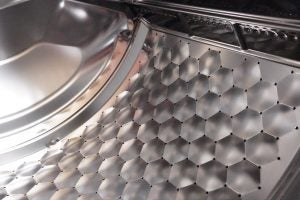
So how eco could the WDB020 be on Cotton Eco cycles then? Not as economical as the standard Cotton programme most of the time in fact. The Cotton Eco programme runs its full 2hrs 59minute duration irrespective of load soiling. It doesn’t offer much energy reduction for smaller loads either.
Running the very same 5.6kg load on Cottons Eco consistently used 0.6kWh of electricity and 45 litres of water. Clearly, for light to medium soiled loads the standard Cottons programme at 40 degrees C is cheaper and quicker to run than the Cotton Eco. The only change-around will be with a full load of really mucky washing. Think team football kit mid-winter on the higher 60 degrees setting. Here the Eco programme will be more, well, eco.
As grass-diving football teams were not handy, we finished most of the remaining tests using the Cotton standard cycle for that reason. Switching down to half-loads of just 2.8kg of mixed cotton garments, we were a bit disappointed as there was not much in the way of further savings. The standard Cotton washes came in at 25 litres of water and 0.29kWh of juice for very lightly soiled loads. Per Kg of clothing washed that is rather less impressive eco credentials, so making sure this machine is fully loaded will keep running costs lowest overall.
Related: Best vacuum cleaner
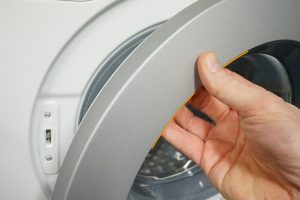
Miele WDB020 – How much will it cost to run?
The variability of measured results depending on cycles, load size and soiling make that a tricky calculation. Assuming a best-case scenario of mixed, daily-worn cotton clothes without too much in the way of mud or hard-core grime, then the WDB020 would almost certainly be at its best using the standard Cottons programme. That would see it use less water and electricity and be quicker to finish than on the Cottons Eco programme.
Our usual annual household wash calculation is 240 loads, split 200 full loads and 40 half loads. With our daily-worn clothes and using only the standard Cottons cycle, this machine is seriously cheap to run. It would use an incredibly low 71.6kWh of electricity and a desert-dry 7,000 litres of water. Billed at 015p/kWh and £3.50 per cubic metre of water, that would be an annual running cost of just £35.24.
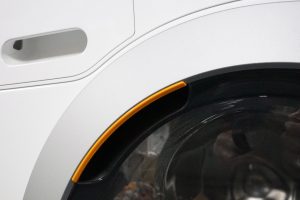
That is a spectacularly low headline running cost for a years’ worth of washing. However, there are a couple of caveats to factor in.
Firstly, the Miele’s dynamic range of consumption is very dependent on load soiling level. If you do have a house full of boisterous kids, those costs will potentially double if you are always washing really dirty loads. Secondly, those figures would only see you clean just over 1200kg of washing in total for the year. A 10kg machine could clean another 500kg of washing for the same number of cycles.
If you are on your own or have a small family, are not prone to daily wrestling with dogs or knee-sliding through the park, this compact capacity and relatively affordable Miele cleans very well and is super frugal with resources.
Buy Now: Miele WDB020 from Appliances Direct from £614 and get it delivered tomorrow
Why buy the Miele WDB020?
One for the smaller family, this ‘budget’ Miele has a limited 7kg drum capacity but returns great wash results and super-efficient running with everyday washing. Mucky loads increase running costs considerably but it still holds its A+++ efficiency rating with pride. Its not the quietest machine we have tested, programme choice is a little limited and spin efficiency is good rather than exceptional. Yet it is supremely simple to use, offers well-considered options including Miele CapDosing and lives up to Miele’s enviable reputation for build quality.
Verdict
A well-made, well-thought-out and incredibly efficient 7kg washer ideal for the smaller family.


